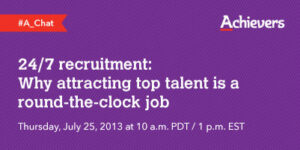Do This, Not That. How to Nail Social Recruiting
It’s not an exaggeration to say that in today’s fast-paced, connected, “always on” world, a social media recruiting strategy is a must have. If you
It’s not an exaggeration to say that in today’s fast-paced, connected, “always on” world, a social media recruiting strategy is a must have. If you

What does it take to attract top talent in today’s world of work? Save the date for a special webinar with experts from Achievers and TalentCulture!

As business looks for new sources of competitive advantage, how can innovative workforce strategies lead the way? HRO Today Forum creator, Elliot Clark, examines the latest research findings with the TalentCulture community…
Remember, this week at TalentCulture, we’re everywhere you want to be! In addition to our regular #TChat events, we’ll be onsite at the Recruiting Trends Social Summit in DC…
Save the date – April 11, 2013 — TalentCulture Community co-founders, Meghan and Kevin will be live at the Recruiting Trends Sourcing and Recruiting Social Summit, sharing insights from the forum on Twitter…
#TChat Teaser Video: Take look at how Jamie defines brand humanization, and explains why it’s important for everyone to understand this concept…
Social media is fundamentally changing every aspect of business. What does this mean for HR and HR practitioners? Employee engagement issues and opportunities abound – but flexibility and innovation are winning the day.
Social learning is everywhere around us – in short, bursty ideas that simultaneously draw us in and distract us from whatever we were intending to accomplish. It also brings us together across the digital divide. It’s time to embrace quality peer-to-peer exchange and shared insights…
Once I dipped my toe into the Twitter pool, I knew there was no turning back. And now here I am one year later, writing the recap for the very chat that indoctrinated me into the social world of work…
Human Resources…what does it mean to most people in today’s workplace? HR is usually seen less a curators of workplace culture and more as the police brought in to direct traffic or quell a riot. So how do we change it up? What can we do to add value?
Analysts estimate that the recruiting/talent industry is a $124 billion industry. So, how are we leading this industry into a brave new social era? That’s what this week’s #TChat is all about…
Join us for the #TChat Radio show tonight at 7 pm ET (4 pm PT) where our special guest is John Sumser, the principal analyst
There are thousands of them: Strategists, Specialists, Editors, Coordinators, Contributors, Community Managers. And that’s just in California. When you search for “social media jobs” on Indeed,
I just finished interviewing potential hires for two open positions at my company, and I was reminded why I founded Come Recommended in the first place.
Weekends aren’t the usual time for companies to drop market-making news, but it happened this weekend, when Monster announced the launch of BeKnown, a networking
Written by Kevin Wang There are core values and ideas that will remain eternal. However, the shape and form in which they manifest themselves constantly
I spent most of this past week at the HRO Today conference in Las Vegas as a member of the blog squad, and what do I
Written by Omowale Casselle Usually, one of the key characteristics of champions is that they have an amazing ability to prevent themselves from making unforced
“Gadgets be gone.” Ah, no truer words have ever been spoken. That was one of my lighter “tweetable” sentiments from yesterday’s HRO Today Forum analyst
We’ve talked before about how hot the theme of ‘innovation’ is. In the technology world, much of what’s filed under ‘innovation’ is related to cloud
Through the years, technologies have transformed many businesses and industries – while displacing others. But from where I stand, emerging social technologies are rapidly transforming HR for the better. Here’s why…
The hiring process is rapidly evolving. If you’re seeking a job in today’s tough business environment, you’ll need to stay ahead of the curve. Here are some tips to help you look like you’re at the front of the pack…
Social recruiting isn’t really about technology – it’s about what you DO with the technology. Bottom line: It’s (still) all about relationships…
Interviewing is central to the recruitment process. How are new technologies shifting the process – and how can both employers and job candidates make better use of these technologies for better hiring decisions?